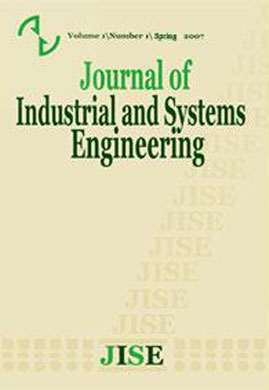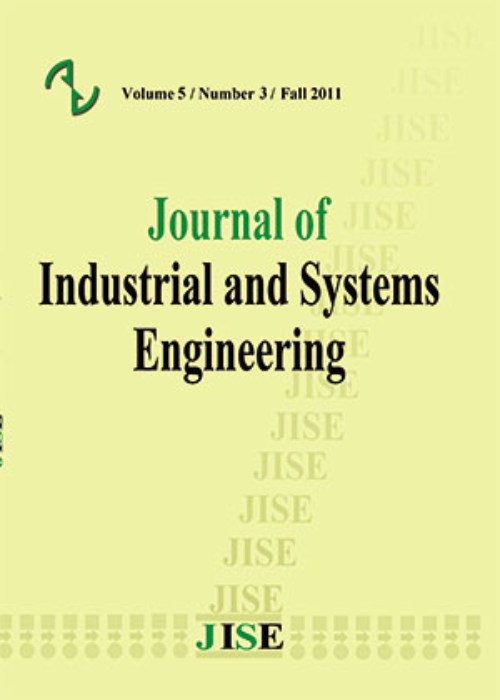فهرست مطالب

Journal of Industrial and Systems Engineering
Volume:1 Issue: 1, Spring 2007
- تاریخ انتشار: 1386/02/11
- تعداد عناوین: 7
-
-
Page 1Suppose an urn contains M balls, of different types, which are removed from the urn in auniform random manner. In the hypergeometric coupon collection problem, we are interested in the set of balls that have been removed at the moment when at least one ball of each type has been removed. In its dual, we are interested in the set of removed balls at the first moment that this set contains all of the balls of at least one type.
-
Page 8We propose a quartic function to represent a family of continuous quality loss functions.Depending on the choice of its parameters the shape of this function within the specification limits can be either symmetric or asymmetric, and it can be either similar to the ubiquitous quadratic loss function or somewhat closer to the conventional step function. We examine this family of loss functions in the context of their industrial applications and use them in a mathematical programming model for the parameter design problem.
-
Page 23In this paper, the problem of determining the best schedule for a set of projects has beenmodeled in the form of a generalized tardiness flowshop (GTF) problem. We develop a set of heuristic algorithms for minimizing the total tardiness of jobs in a GTF problem. In the generalized version of tardiness flowshop problems, a job is considered to be a collection of operations and there is a due date associated with the completion of each operation on each machine. Four algorithms based on the concept of “apparent tardiness cost” (ATC) are developed for solving the GTF problem. The relative effectiveness of the developed algorithms will then be evaluated through an extensive computational experiment.
-
Page 37This paper introduces an analytical method for approximating the performability of a firm realtime system modeled by a multi-server queue. The service discipline in the queue is earliestdeadline- first (EDF), which is an optimal scheduling algorithm. Real-time jobs withexponentially distributed relative deadlines arrive according to a Poisson process. All jobs have deadlines until the end of service and are served non-preemptively. An important performance measure to calculate is the loss probability. The performance of the system is approximated by a Markovian model in the long run. A key parameter, namely, the loss rate when there are n jobs in the system is used in the model, which is estimated by partitioning the system into two subsystems. The resulting model can then be solved analytically using standard Markovian solution techniques. The number of servers in the system may change due to failure or repair. The performability of the system is evaluated in the presence of such structural changes. The latter measure is approximated by a Markov reward model, considering the loss probability as the reward rate. Comparing numerical and simulation results, we find that the existing errors are relatively small.
-
Page 56Quality Function Deployment (QFD) has been traditionally used as a planning tool primarilyfor product development and quality improvement. In this context, many people have used QFD for making decisions on how to prioritize critical product areas from a customer perspective. However, it is the position of the author that the QFD process can be viewed as a decision support system that would encompass multiple facets of information to enhance the quality and output of the decision making process in the course of product development. In this paper, the author submits the QFD process in combination with other engineering decision making tools such as the Pugh concept selection and the Kepner-Tregoe analysis technique as a decision making and modeling process that is as old as management science itself. Specifically, the attempt is made to illustrate how QFD provides an iterative sequence of steps involved in decision making, from the initial problem identification to a proposal for the actual implementation plan. To make this position more applicable to the reader, the subject has been approached from an actual business environment.
-
Page 70In this paper a new method based on fuzzy theory is developed to solve the project scheduling problem under fuzzy environment. Assuming that the duration of activities are trapezoidal fuzzy numbers (TFN), in this method we compute several project characteristics such as earliest times, latest times, and, slack times in term of TFN. In this method, we introduce a new approach which we call modified backward pass (MBP). This approach, based on a linear programming (LP) problem, removes negative and infeasible solutions which can be generated by other methods in the backward pass calculation. We drive the general form of the optimal solution of the LP problem which enables practitioners to obtain the optimal solution by a simple recursive relation without solving any LP problem. Through a numerical example, calculation steps in this method and the results are illustrated.
-
Page 81This paper experiments application of different heuristic approaches to a real facility layoutproblem at a furniture manufacturing company. All the models are compared using AHP,where a number of parameters of interest are employed. The experiment shows that formal layout modelling approaches can be effectively used real problems faced in industry, leading to significant improvements.


